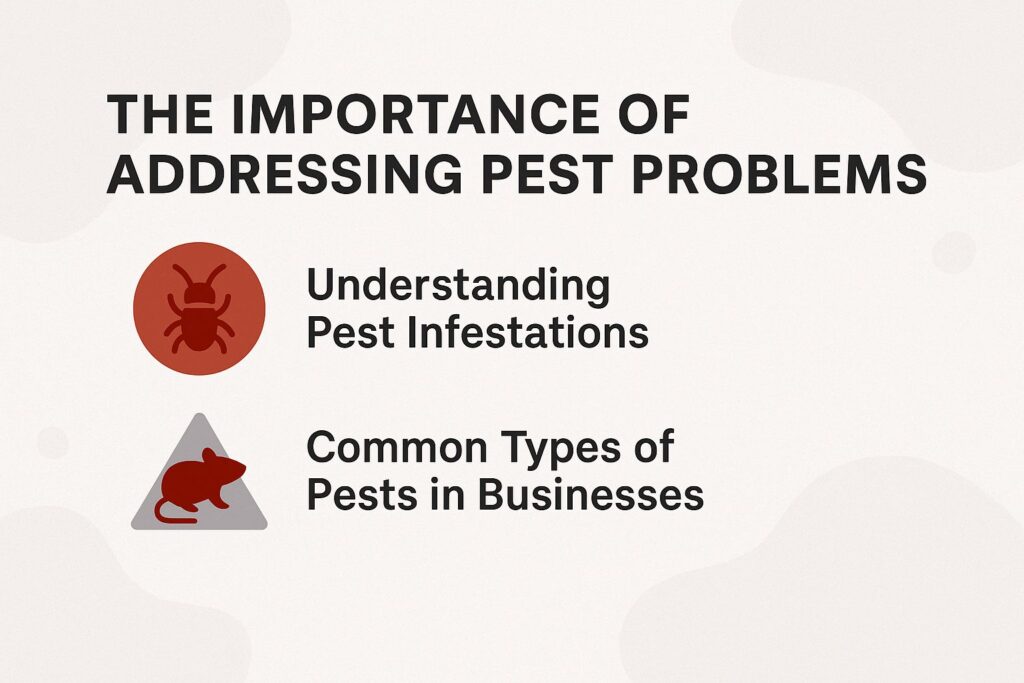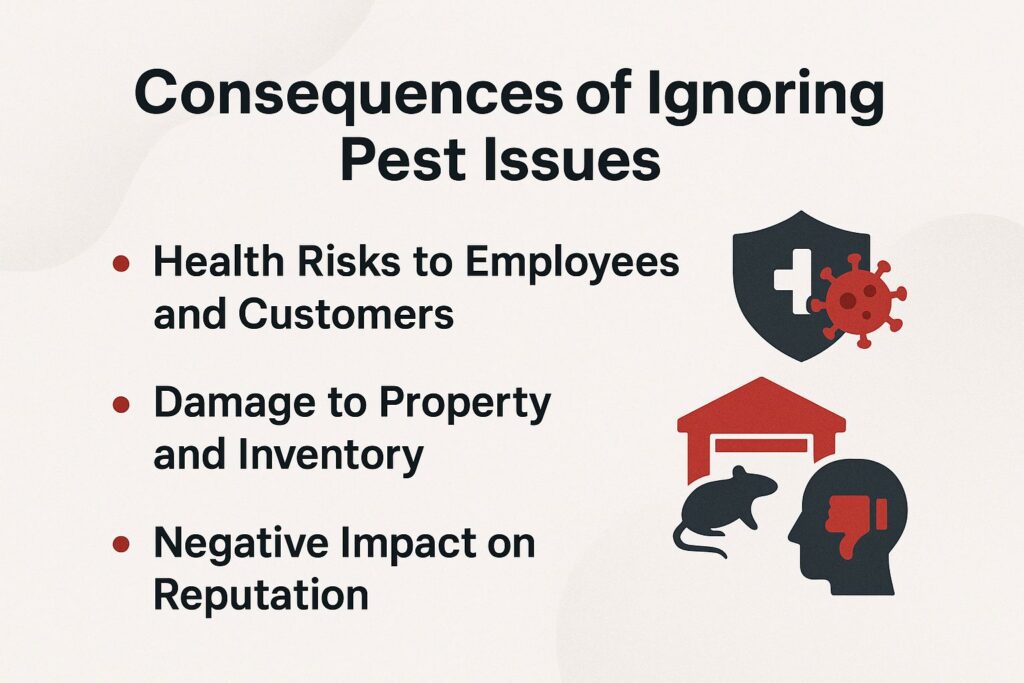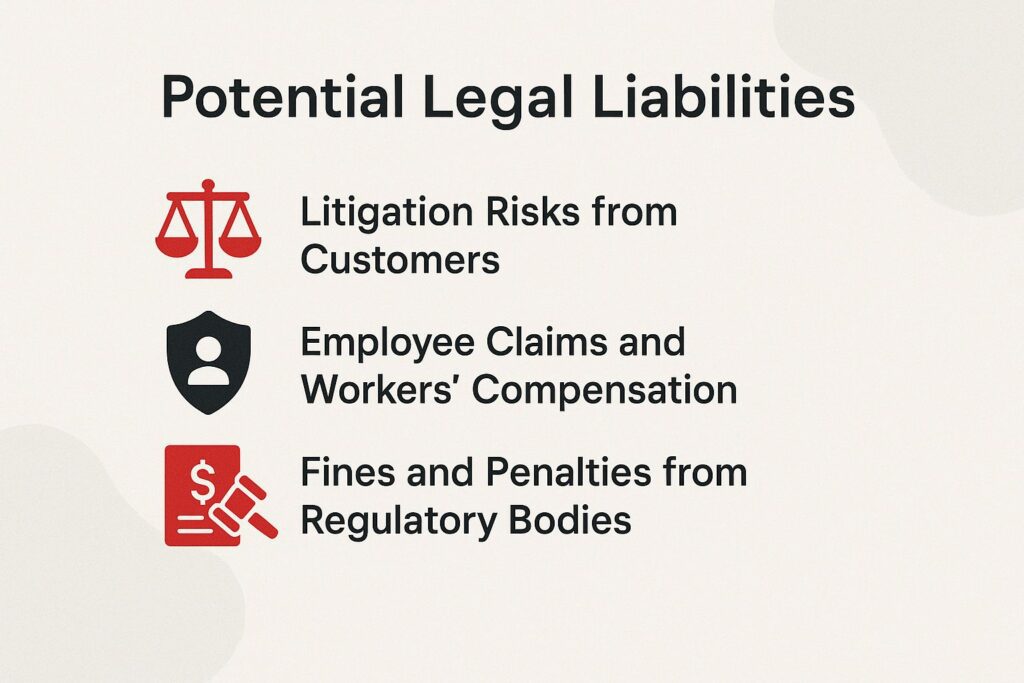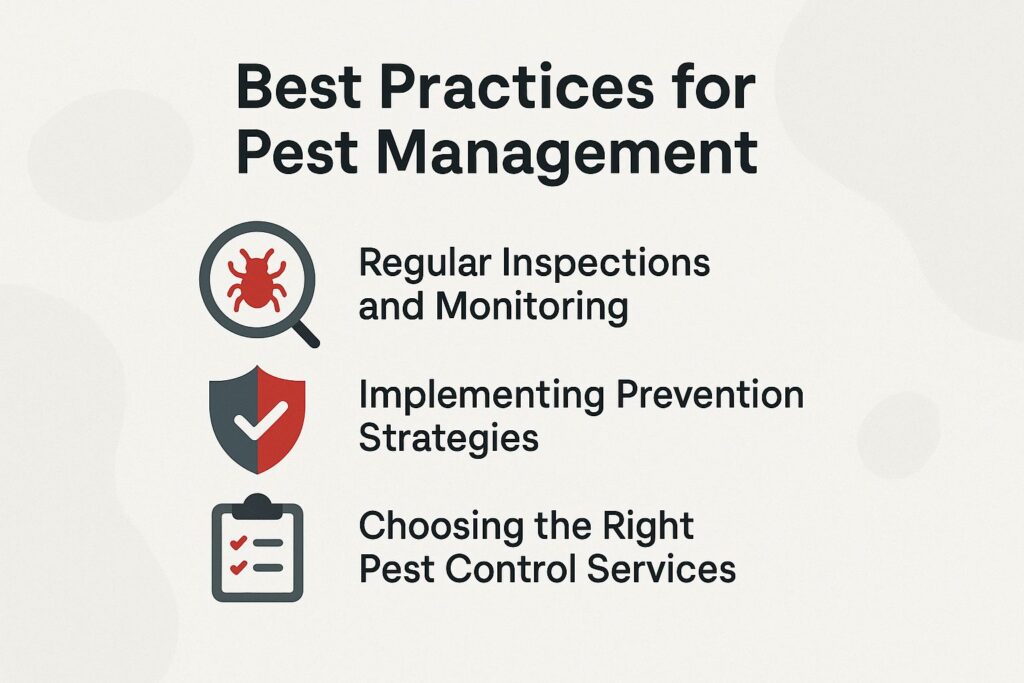
The Legal Risks of Ignoring Pest Problems in Your Business
Ignoring pest problems in your business might seem like a minor issue, but the stakes are high. Beyond the visible nuisances, lurking pests can lead to serious legal troubles. From health regulations to potential lawsuits, the implications of inaction can spiral out of control. Learn about the pests that could enter your area, your legal responsibilities, and the expensive results of ignoring them. Don’t wait for a pest invasion to take a toll on your business-understand the risks now.
The Importance of Addressing Pest Problems

Recognizing and dealing with pest issues ahead of time is important for keeping a business both safe and within regulations, as pest infestations can cause serious financial and legal problems, including business liability. For businesses looking to protect themselves, understanding the financial impact of pest problems is crucial, as highlighted in our analysis of how to protect your business from costly infestations.
Understanding Pest Infestations
Pest infestations occur when pests find optimal conditions for survival in a business environment, leading to potential health risks and property damage.
Various conditions in the environment lead to pest issues. For instance, unsanitary conditions like food spills attract pests, while standing water provides a breeding ground for mosquitoes, highlighting the need for pest prevention strategies.
In fact, 30% of businesses experience pest issues annually. To address this issue, set up routine cleaning plans, close food containers tightly, and repair leaks quickly.
Consider using pest monitoring tools such as traps or digital sensors that alert you to infestations early, significantly reducing the risk of a full-blown crisis and ensuring pest management compliance.
Common Types of Pests in Businesses
Businesses face various pest threats, including rodents like mice and rats (20% of commercial properties affected), insects like cockroaches, and termites that can cause significant structural damage.
Plus rodents and termites, commercial properties often encounter pests like ants, which can contaminate food, and bedbugs, known for their rapid population growth and significant nuisance.
For instance, the National Pest Management Association indicates that 97% of pest control professionals have treated for bedbugs in the past year.
Implementing an Integrated Pest Management (IPM) strategy helps combat these issues by assessing pest presence, identifying entry points, and using a combination of traps and eco-friendly pesticides.
Regular checks and quick action can reduce risks and lower expenses related to pests, contributing to effective risk mitigation.
Legal Obligations for Businesses
Businesses need to follow different legal rules about pest control to keep employees and customers safe and to prevent expensive fines, ensuring proper compliance with health and safety laws. Related insight: Protecting your business from costly infestations is crucial for maintaining these standards.
Health and Safety Regulations
Health regulations require businesses to maintain pest-free environments to safeguard public health, with specific guidelines outlined by OSHA and local health departments.
For instance, restaurants must pass pest inspections quarterly, ensuring all food handling areas are free from infestations. Establishments must implement proper waste management practices to minimize attractants.
Tools such as pest control software can monitor inspections and treatments, while training programs for employees make sure they follow the best methods, aligning with workplace safety and public health standards.
Local health codes often dictate specific thresholds for pest activity; businesses exceeding these may face fines or temporary closures. Doing regular checks and quickly addressing problems can greatly reduce risks and maintain community standards.
Local and State Laws
Local and state laws usually set the rules on how often and in what ways pest control should be done. These rules can differ a lot from one place to another, impacting whether operations follow the law. It’s important to know local rules and what tenants need to do.
For instance, California requires pest inspections for commercial properties prior to sale or lease, ensuring any existing infestations are managed before transactions.
Unlike other places, New York requires landlords to perform yearly checks for pests, especially in buildings with multiple apartments. Failing to comply with these regulations can result in hefty fines and legal liabilities.
Therefore, businesses should learn about local laws and hire pest control experts who know the rules in your area to follow them properly.
Industry-Specific Guidelines
Different industries have specific pest control rules; for example, the food industry must follow strict procedures to keep products safe, adhering to industry standards and ethical obligations.
The FDA requires food service businesses to regularly check for pests and keep records of their pest control actions.
Meanwhile, healthcare facilities follow guidelines from the CDC concerning pest management, which emphasize the importance of maintaining a pest-free environment to prevent the spread of disease.
The hospitality industry, according to the EPA, needs to make sure their pest control methods follow Integrated Pest Management (IPM) rules. This includes routine checks and training staff to maintain cleanliness.
Each of these industries needs to keep detailed records of their pest control actions to comply with regulations.
Consequences of Ignoring Pest Issues

Ignoring pest problems can cause serious issues, including health risks for employees and customers and significant financial losses from property damage.
Health Risks to Employees and Customers
Pests can carry diseases that pose significant health risks to both employees and customers, with studies indicating that 46% of commercial pest incidents lead to health complaints.
Common pests such as rodents and cockroaches can transmit diseases like hantavirus and salmonella, respectively. To reduce these risks, businesses should put in place a complete pest control plan.
Start by inspecting your home every month to identify any signs of pests. Use traps and natural deterrents, such as peppermint oil, for quick results. Maintain proper sanitation by sealing food and waste tightly, which deters pests.
Research shows that these preventive steps can lower health problems related to pests by as much as 70%, creating a safer place for all.
Damage to Property and Inventory
Pests can cause serious harm to property and stock, with termites alone leading to about $40 billion in damages each year in the U.S., underlining the importance of liability risk assessment.
Other pests, such as rodents, can chew through wires, causing electrical fires and leading to repair costs averaging $6,000.
Bed bugs can damage stock in hotels or stores, leading to expensive treatments that may cost more than $1,000 for each affected area.
To mitigate these risks, businesses should invest in regular pest inspections and maintenance plans.
Using pest management software and working with licensed exterminators can help track infestations, allowing for a quick response and reducing financial losses.
Negative Impact on Reputation
A pest problem can harm a business’s image, as more than 30% of customers say they would stay away from a business after seeing pests, emphasizing the impact on business reputation and client relations.
For example, a well-known restaurant chain faced a social media backlash after a video of a rat in their kitchen went viral. This incident led to a 20% drop in customers during the following months.
A local hotel got bad reviews because of a bed bug problem. This caused customers to lose trust and cancel many reservations.
To mitigate such risks, businesses should implement regular pest inspections, maintain cleanliness, and train staff on early detection and response strategies.
Potential Legal Liabilities

If companies do not control pest problems, they could face legal problems, such as being sued by customers or receiving health-related complaints from employees, demonstrating failure in legal obligations and tenant rights. Implementing proper pest control measures is crucial; those interested in safeguarding their business from infestations may find insights in our guide to protecting your business from costly infestations.
Litigation Risks from Customers
Failure to address pest problems can result in lawsuits from customers, especially if they suffer health issues attributed to pests, increasing financial liability for businesses.
For instance, a restaurant in Texas was sued after customers contracted foodborne illnesses due to rodent infestations. The court ruled in favor of the plaintiffs, highlighting negligence by the business.
To file a claim, customers should document evidence, such as photographs of pests or health symptoms, and gather witness statements. Next, they should contact the business to express their concerns formally.
If unresolved, they may escalate the matter to a legal representative who can guide them through filing a complaint with local health authorities or pursuing litigation.
Employee Claims and Workers’ Compensation
Employees exposed to harmful pests can file workers’ compensation claims, which can lead to significant financial repercussions for businesses.
For instance, if an employee develops health issues from exposure to roaches or bedbugs, they may claim medical expenses, lost wages, and even pain and suffering.
Legal expenses can increase rapidly, with settlements potentially ranging from a few thousand dollars to tens of thousands, based on how serious the case is. Businesses may also face damage to their reputation, leading to loss of customers.
To mitigate risks, companies should regularly inspect for infestations and implement pest control measures, thus safeguarding both employees and the bottom line, integrating pest control policies and corporate responsibility into business operations.
Fines and Penalties from Regulatory Bodies
Firms that ignore pest control rules could be fined a lot, sometimes as much as $10,000, based on how serious the breach is.
For example, in 2021, a pest control company in California was fined $15,000 for using unregistered pesticides, a violation of both state and federal laws. Similarly, a restaurant in New York faced a $7,500 penalty for failing to maintain proper pest control records.
These fines drain money and harm the business’s reputation. To prevent these problems, companies should:
- Hold regular training sessions for employees on compliance.
- Use pest control software to monitor treatments.
- Keep detailed inspection records.
Insurance Considerations
It’s important for businesses to understand how insurance works, particularly with pest-related claims, regulatory compliance, and the limits of their liability insurance policy.
Coverage for Pest-Related Claims
Most general liability insurance policies can cover pest-related claims, but coverage specifics, including environmental health and pest-related diseases, can vary widely among providers.
When evaluating insurance for pest-related claims, focus on three key aspects: coverage limits, exclusions, and claims procedures.
For instance, a policy with a minimum coverage limit of $1 million is often advisable to provide adequate protection against pest infestations liability. Verify if the policy details exclusions for specific pests, such as termites or rodents, which may require separate riders.
Learn how to file insurance claims; a simple method can help you save time during urgent situations. Reviewing these points will help make sure your business is fully protected from issues caused by pests and related legal problems.
Exclusions and Limitations in Policies
Insurance policies often have clauses that reduce or remove coverage for damage caused by pests, leading to potential legal actions. Businesses need to know these restrictions and regulatory compliance requirements.
Common exclusions in pest insurance policies include:
- pre-existing infestations
- damages resulting from negligence
- certain types of pests like rodents or termites, which may require separate coverage or extermination services
To reduce these risks, businesses should perform regular inspections and use preventive pest control methods. Utilizing tools like pest monitoring systems or hiring professional pest management services can help identify issues early.
Reviewing insurance policies every year ensures that the coverage matches changing business needs and legal requirements.
Best Practices for Pest Management

Using effective pest control methods is essential for keeping your area free of pests and complying with health inspections and safety rules. If you’re wondering about the best approach for your specific needs, our expert tips on how to choose the right pest control service might offer the guidance you need.
Regular Inspections and Monitoring
Carrying out regular checks and keeping an eye on things can cut the chance of pest problems, including pest hazards, by half when done regularly all year round.
Businesses should aim for quarterly inspections, with additional checks during peak seasons.
A detailed list might include:
- Checking for cracks in walls
- Assessing food storage areas
- Inspecting plumbing for leaks
Tools like PestRoutes can make scheduling easier for managers, helping them set alerts and keep an eye on inspection results. Documenting findings can help identify patterns over time, enabling proactive measures.
Employees should also be trained to recognize signs of pests, ensuring that any issues are reported immediately as part of pest problem reporting measures.
Implementing Prevention Strategies
Using complete prevention plans can greatly reduce the chance of pest problems and pest infestations liability, with active steps lowering cases by as much as 70%.
Important steps are:
- Cleaning up to remove food
- Blocking places pests can get in
- Setting up strong staff training plans
For instance, regular cleaning schedules can reduce attractants, while inspecting and closing gaps in walls and doors can fortify defenses. Teaching staff to spot early signs of infestations helps them respond quickly.
Studies indicate that companies using these methods see a 30% drop in pest complaints in the first year, proving they work well for health and running the business smoothly.
Choosing the Right Pest Control Services
Choosing the best pest control service is important. Companies should check certifications, service procedures, and customer feedback to guarantee good service.
To effectively evaluate pest control providers, ask key questions such as:
- What licenses do you hold?
- Are you a member of the National Pest Management Association (NPMA)?
- What safety measures do you employ?
Look for certifications like the NPMA’s QualityPro, which signifies a commitment to industry standards. Review online ratings and testimonials to gauge customer satisfaction and inquire about their treatment options-opt for eco-friendly solutions if sustainability is a priority for your business.
A complete review of these factors will help make informed decisions.
Summary of Legal Risks
Legal problems from pest issues can lead to significant expenses and interfere with business activities, needing proactive management plans, including pest control compliance.
To lower these risks and keep business running smoothly, companies should create clear pest control plans that include regular checks and upkeep tasks.
For example, using a certified pest control service follows health regulations and reduces insect infestations risks. Checking your pest control plan every three months helps identify problems.
Employees should also receive training on pest awareness and reporting processes to prevent escalations. By embedding these practices into your operations, you can significantly reduce the likelihood of costly legal repercussions.
Call to Action for Business Owners
Business owners should make a pest control plan that covers regular checks, staff training, knowledge of pest-related lawsuits, and working with licensed pest control experts.
- Start by scheduling quarterly inspections with a certified pest control service to identify potential infestations early.
- Hold employee training sessions on spotting pests and learning how to prevent them, like storing food correctly and keeping things clean.
- Collaborate closely with pest control experts to develop customized strategies that address your specific business needs, ensuring legal compliance while maintaining a pest-free environment.
- Prioritize these steps to protect your investment and safeguard your reputation-act now for a proactive approach to pest management.
About the Author
Written by Kevin McAlister, a Cornell University graduate with a degree in agricultural biology, entomology, and bioagricultural sciences. I’m the owner of a successful pest control company in Delaware and a writer and editor for Pest Extinct. For the past nine years, I’ve specialized in sustainable, science-based pest control solutions for residential and commercial clients across the Northeast.

Leave a Reply